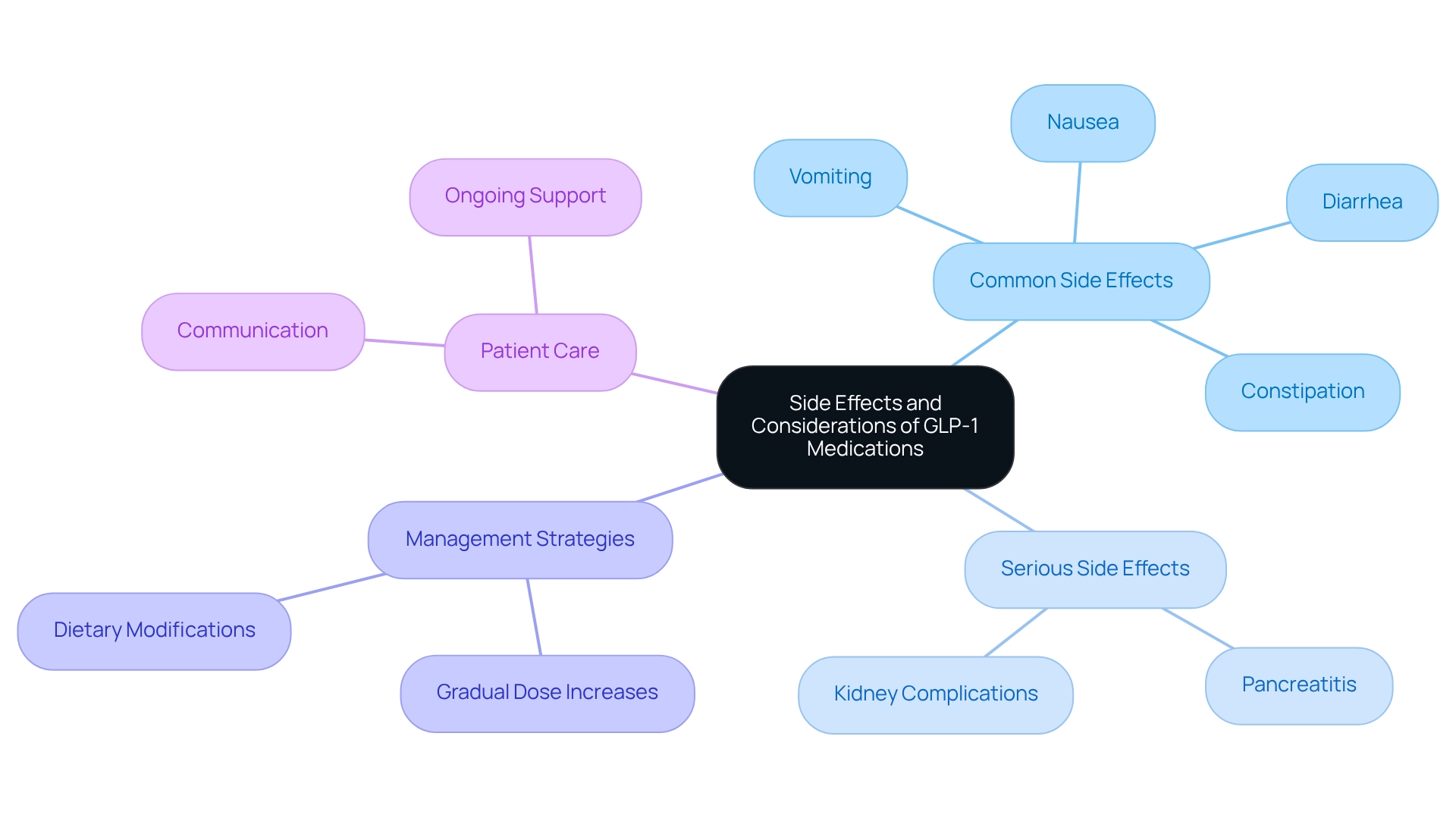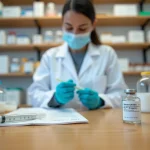Overview
If you’re feeling overwhelmed by your weight loss journey, know that you’re not alone. GLP-1 drugs can be a compassionate ally in regulating blood sugar levels and appetite. They work by:
- Stimulating insulin secretion
- Inhibiting glucagon release
- Slowing gastric emptying
These mechanisms not only help manage your blood sugar but can also lead to significant weight loss, which is so important for your overall health.
Research shows that these medications can be effective in managing obesity and type 2 diabetes. In fact, studies indicate that patients can achieve an average body mass reduction of up to 20% when they combine these drugs with lifestyle changes. Imagine the difference that could make in your life!
We understand that taking the first step can be daunting, but remember, together we can achieve your goals. Consider discussing with your healthcare provider whether GLP-1 medications might be a good fit for you. You’re taking a positive step toward a healthier future, and we’re here for you every step of the way.
Introduction
In the quest for effective solutions to combat obesity and type 2 diabetes, GLP-1 drugs have emerged as a groundbreaking advancement in medical treatment. These innovative medications, which mimic the action of the naturally occurring hormone GLP-1, not only regulate blood sugar levels but also significantly aid in appetite control and weight loss. Have you ever felt overwhelmed by your weight loss journey? You’re not alone. With studies revealing remarkable results—patients losing an average of 20% of their body weight—GLP-1 drugs like Tirzepatide and Semaglutide are transforming the landscape of diabetes management and weight loss strategies.
As healthcare professionals continue to explore their multifaceted mechanisms and benefits, understanding the role of these medications becomes crucial for those seeking to improve their health outcomes. Together, we can achieve your goals. This article delves into the mechanisms, benefits, and evolving landscape of GLP-1 drugs, offering insights into their potential to reshape the future of obesity and diabetes treatment. We’re here for you, and we hope to provide the support you need on this journey.
Understanding GLP-1 Drugs: Mechanisms and Benefits
Glucagon-like peptide-1 medications represent a significant advancement in managing obesity and type 2 diabetes, raising an important question: how do GLP-1 drugs work? These medications, including Compounded Tirzepatide, are designed to effectively regulate blood sugar levels and appetite. They stimulate insulin secretion in response to meals, inhibit glucagon release—which usually raises blood sugar levels—and slow gastric emptying, demonstrating how GLP-1 drugs enhance feelings of fullness.
The benefits of these medications extend well beyond blood sugar control; they play a vital role in encouraging significant reductions in body mass. Recent research indicates that patients using certain drugs can achieve an average reduction in mass of up to 20%, based on data from over 70,000 individuals who underwent therapy for at least six months. This remarkable efficacy positions Tirzepatide and similar medications as valuable tools for those struggling with weight management.
Moreover, these medications not only help regulate appetite but also significantly aid in managing blood sugar levels, making them particularly advantageous for individuals with diabetes. The dual action of enhancing satiety while regulating blood sugar levels illustrates how GLP-1 drugs serve as a cornerstone in comprehensive fat reduction and diabetes management strategies. Minimal’s holistic methods for reducing body mass, including Metformin and personalized health journeys starting at $99.99/month, further reinforce this supportive approach.
Are you ready to take the first step towards a healthier, more fulfilling life with optimal results? Discover more about Compounded Tirzepatide and how it can help you achieve your weight loss goals. Experts emphasize the importance of these treatments in today’s healthcare landscape. Eric Polley, a PhD and data science expert from UChicago, shares, “If cardiovascular health is what you think is important for deciding between these drug classes, I think our most recent study provides some strong evidence.”
This highlights the growing recognition of these drugs in addressing metabolic health challenges. As healthcare evolves, the integration of specific therapies into treatment strategies reflects a commitment to tackling the complex issues of obesity and diabetes with innovative solutions. Minimal emphasizes transformative care and long-term health outcomes, ensuring that clients not only achieve weight loss but also maintain their health improvements over time. It is also essential to understand potential side effects, such as stomach discomfort or reduced vitamin B12 levels, for safety and wellness insights. Together, we can navigate this journey towards better health.
Overview of Popular GLP-1 Medications: Ozempic, Wegovy, and Others
Ozempic and Wegovy stand out as notable medications in their class, both featuring the active ingredient semaglutide. While Ozempic is primarily prescribed for managing type 2 diabetes, Wegovy has received specific approval for the chronic management of body mass. It works by mimicking the hormone glucagon-like peptide-1, which brings to light an important question: how do GLP-1 drugs help regulate appetite and food consumption, leading to significant weight loss?
Research shows that individuals using Wegovy, in combination with a lower-calorie diet and increased physical activity, can achieve remarkable results. Some clients of Minimal have reported shedding up to 20% of their body mass after just six months of treatment. This is a testament to the potential of these medications when paired with supportive lifestyle changes.
In addition to Ozempic and Wegovy, other GLP-1 treatments include:
- Saxenda (liraglutide), also indicated for body mass management
- Trulicity (dulaglutide), which is mainly utilized for diabetes control
The dosing frequency varies among these medications; some require weekly injections, while others need daily administration. This variability can significantly affect patient adherence and preferences, as many individuals appreciate the convenience of less frequent dosing.
Wegovy is administered through a subcutaneous injection once a week, using a pre-filled pen for ease of use. While it is generally well-tolerated, some potential side effects may include:
- Nausea
- Vomiting
- Upset stomach
- Stomach pains
- Constipation
- Diarrhea
- Heartburn
- Acid reflux
- Belching and gas
- Dizziness
- Headaches
- Fatigue
Fortunately, these symptoms often improve within the first few weeks of treatment. Positive feedback from Minimal customers using Wegovy through programs like Minimal highlights the effectiveness of this personalized health solution.
As one satisfied customer shared, “I love my axiofit fit tope!” This statement emphasizes the importance of a supportive and stigma-free approach to weight management. Healthcare professionals like Dr. Na Shen advocate for treating obesity as a chronic condition that deserves serious attention and care. Together, we can achieve your goals, and we’re here for you every step of the way.
How GLP-1 Drugs Work: Appetite Suppression and Metabolic Effects
Mounjaro and similar medications beautifully illustrate how GLP-1 drugs work through various mechanisms that greatly influence metabolic processes and appetite control. If you’re wondering how GLP-1 drugs function, it’s essential to recognize that they primarily enhance insulin secretion in a glucose-dependent manner, effectively lowering blood sugar levels when they are elevated. This targeted action is complemented by the suppression of glucagon secretion, which prevents excessive glucose release from the liver into the bloodstream.
A pivotal effect of GLP-1 medications is their ability to slow gastric emptying, leading to the important question: how do GLP-1 drugs work to extend the sensation of fullness after meals? This appetite suppression is crucial for weight loss, as it directly contributes to a decrease in overall caloric intake. Mounjaro, specifically, has been shown to help individuals achieve and maintain a healthier weight by reducing hunger and increasing feelings of fullness.
Research indicates that individuals using these drugs experience notable decreases in appetite, prompting further questions about how GLP-1 drugs work. Studies show that these medications can lead to a significant reduction in daily caloric intake. However, it’s important to acknowledge that the discontinuation rate of these agonists due to adverse effects is approximately 10%, highlighting potential challenges linked to their use.
Furthermore, understanding how GLP-1 drugs work reveals that these medications affect brain pathways that control appetite, enhancing their efficacy in managing body mass. Recent findings suggest that changes in food preferences and taste sensitivity might also contribute to the weight loss observed by individuals using analogues of glucagon-like peptide-1. For example, case studies have highlighted the potential of these treatments to not only assist in obesity management but also to influence cravings for substances like alcohol and tobacco, indicating a broader therapeutic potential.
One insightful case analysis, ‘Potential of Analogues Beyond Weight Loss,’ underscores these effects, illustrating the drugs’ impact on food choices.
In terms of metabolic effects, understanding how GLP-1 drugs work reveals that medications like Mounjaro have been shown to enhance insulin sensitivity and encourage a healthier metabolic profile. The most recent research has evaluated various results associated with appetite and gastric emptying, with many employing glucagon-like peptide-1 infusion, Liraglutide, or Semaglutide as interventions compared to placebo or alternative therapies. This thorough approach highlights the varied advantages of these medications, making them a beneficial choice for individuals pursuing effective management solutions for their body mass.
Mounjaro is administered as a once-weekly injection under the skin of the stomach, thigh, or upper arm, and it is crucial to use it alongside a balanced diet and regular exercise for optimal results. As Dr. Chance Miller notes, “Clients appreciate the personalized attention from a dedicated care team, which includes physicians like Dr. Chance Miller, who emphasize transformative care.” This personalized support is vital for clients navigating their weight loss journeys, reminding us that together, we can achieve your goals.
Side Effects and Considerations of GLP-1 Medications
These drugs, while typically well-accepted, may lead to various side effects, particularly digestive issues. Commonly reported side effects include nausea, vomiting, diarrhea, and constipation. Often, these symptoms lessen over time as the body adjusts to the treatment.
However, it’s important to note that serious side effects, although rare, can occur, such as pancreatitis and kidney complications. Observing these negative effects is crucial, especially in the early phases of therapy. Recent data indicates that gastrointestinal side effects are prevalent among users of these medications, with research showing that around 30% of patients experience some form of gastrointestinal discomfort.
Understanding how GLP-1 drugs work reveals that GLP-1 receptor agonists can lower hemoglobin A1c by about 1% compared to control groups in patients with Type 2 Diabetes Mellitus (T2DM), underscoring their effectiveness in glycemic control. This highlights the importance of healthcare providers discussing potential side effects with patients before starting treatment, ensuring they are well-informed and prepared to manage any discomfort that may arise.
At Minimal, we understand that effective solutions for shedding excess pounds require a holistic approach. Our services include personalized weight loss prescriptions, such as Semaglutide and compounded Tirzepatide, along with nutrition guidance, fitness training, breathwork, and acupuncture tailored to individual needs. This comprehensive support empowers our clients to navigate the challenges of managing their body mass while addressing any side effects they may encounter.
Expert insights emphasize the necessity of a collaborative team approach in effectively managing these side effects. Healthcare providers, including physicians and nutritionists at Minimal, work together to develop strategies that help mitigate gastrointestinal symptoms. For instance, gradual dose increases and dietary modifications can significantly enhance patient tolerance to these medications.
A case study examining the toxicity of glucagon-like peptide analog overdoses found that while symptoms like nausea and abdominal pain were common, severe complications such as pancreatitis or hypoglycemia were typically not observed. This underscores the importance of supportive care and patient education regarding potential toxic ingestion, further reinforcing the need for ongoing communication between patients and their healthcare teams.
Moreover, some diabetics have reported difficulties accessing their previously prescribed medications, as noted by Pierce Logan, a Graduate Assistant at the Indiana University Center for Bioethics. This highlights the challenges faced by patients using specific therapies and the importance of addressing these concerns in relation to managing body mass and blood sugar regulation.
In summary, while these treatments offer significant benefits for body mass management and blood sugar control, understanding how GLP-1 drugs work and addressing their side effects is vital for improving patient outcomes. At Minimal, we are dedicated to providing personalized care and comprehensive support, including regular check-ins and clinician assistance, to help our clients achieve lasting health improvements.
GLP-1 Drugs and Their Role in Managing Obesity and Diabetes
Medications for obesity and type 2 diabetes have become essential tools in our journey toward better health. Understanding how GLP-1 drugs work offers a dual advantage: they help control blood sugar levels while promoting weight loss. At Minimal, we’re dedicated to incorporating specific therapies into our tailored solutions for reducing body mass. This ensures that every patient receives the comprehensive support they need, tailored to their unique circumstances. Clinical studies indicate that those using targeted treatments can achieve significant weight loss, often exceeding 10% of their body mass.
Such a level of weight reduction is not just a number; it plays a vital role in enhancing metabolic health and reducing the risk of diabetes-related complications. Looking ahead to 2025, the role of these treatments continues to evolve. Ongoing research is highlighting their cardiovascular benefits, including a reduced risk of heart attack and stroke. These findings underscore the importance of integrating these medications into holistic treatment plans for individuals facing obesity and diabetes.
Interestingly, data reveals that individuals without diabetes experience a greater average percentage of weight loss at six months (11.8%) compared to those with type 2 diabetes (7.2%). This suggests that the effectiveness of these treatments may vary based on underlying health conditions, which is crucial to consider.
At Minimal, we also offer personalized fitness programs and nutrition guidance, essential components for fostering lasting health improvements. Dr. Chance Miller notes, “Clients appreciate the personalized attention from a dedicated care team, which includes physicians like myself, who emphasize transformative care.”
This tailored approach is vital for ensuring patient satisfaction and adherence to treatment. Remarkably, only 11.1% of members changed their product during a one-year assessment, indicating a strong level of satisfaction with their initial treatment choice. This stability in treatment adherence is crucial for achieving long-term health benefits.
Despite their effectiveness, the high cost of these treatments can be a barrier for many. Researchers are advocating for alternative, more economical programs for reducing body mass. This includes explaining how GLP-1 drugs can work alongside more affordable interventions to help maintain health benefits while lowering overall healthcare expenses. Additionally, the long-term side effects of these treatments require further investigation, raising concerns about potential negative repercussions when used off-label for weight loss.
As we navigate the ever-changing landscape of obesity and diabetes management, these medications are likely to remain a vital part of our collective pursuit of improved health outcomes. Together, with Minimal’s comprehensive approach to health and wellness, we can make significant strides toward achieving your health goals.
Personalized Approaches to Weight Loss: Integrating GLP-1 Medications
Incorporating glucagon-like peptide-1 treatments into customized weight loss strategies can significantly enhance treatment outcomes. We understand that each patient’s journey is unique, shaped by their medical history, lifestyle, and personal preferences. Healthcare providers, like Dr. J. Chance Miller at Minimal, play a vital role in collaborating with patients to develop comprehensive strategies that integrate specific medications with personalized nutritional advice and exercise. Dr. Miller emphasizes, “clients appreciate the personalized attention from a dedicated care team, which includes physicians who emphasize transformative care.” This individualized approach not only boosts adherence to treatment but also fosters a supportive environment that encourages sustainable lifestyle changes.
As a result, patients are more likely to achieve their health goals, leading to improved overall well-being. Have you considered how these treatments could fit into your journey?
Statistics show that certain medications are typically administered once a week, making them a convenient choice for many individuals. Additionally, a recent KFF Health Tracking Poll indicates that a considerable majority of adults—61%—support Medicare coverage for specific drugs aimed at reducing body mass. This growing awareness highlights the importance of incorporating these medications into treatment strategies, as they are increasingly viewed as essential tools in the battle against obesity.
Real-world examples illustrate the effectiveness of personalized reduction strategies, shedding light on how GLP-1 drugs work. Many clients have reported significant weight loss, with some achieving reductions of up to 20% of their body mass. One client, Deborah N., shared, “I love my axiofit fit tope!”
This success is often linked to the tailored nature of their treatment, aligning with expert insights on how GLP-1 drugs support individualized approaches to weight management. Dietitians advocate for the inclusion of specific medications in treatment plans, noting that such strategies can lead to more effective and lasting results.
As adult obesity in the U.S. approaches around 40%, with severe obesity affecting 9% of the population, the potential benefits of receptor agonists are substantial. With approximately 100 million individuals possibly benefiting from these treatments, the societal cost of obesity—estimated at $120 billion annually—underscores the urgent need for effective management solutions. By focusing on tailored strategies for weight reduction that include specific medications, healthcare professionals can help clients overcome their unique challenges and achieve lasting health improvements.
Dr. Miller, fluent in Spanish, is committed to providing compassionate care to a diverse patient population, ensuring that everyone receives the support they need on their weight loss journey. Together, we can achieve your goals.
Future Directions in GLP-1 Drug Research and Development
Research into these drugs is progressing at an impressive speed, with many studies currently underway focusing on new formulations, delivery methods, and combination therapies. One of the most promising advancements on the horizon is the potential introduction of oral diabetes drugs. This could significantly improve patient adherence by offering a non-injection alternative, making treatment more accessible and convenient for those who may feel overwhelmed by their options.
Moreover, researchers are exploring the synergistic effects of combining certain drugs with other therapeutic agents. This approach aims to enhance weight loss results and provide additional metabolic benefits, thus broadening the therapeutic uses of related treatments. As the scientific community deepens its understanding of this peptide’s multifaceted role in various physiological processes, new applications for these treatments are likely to emerge, reinforcing their essential role in managing obesity and diabetes.
Recent statistics indicate that roughly 1 in 4 adults with heart disease have utilized a specific type of drug, highlighting the growing acceptance and reliance on these treatments in clinical practice. However, despite their effectiveness, affordability remains a significant barrier, with half of the users reporting challenges in accessing these treatments. This underscores the urgent need for ongoing research and development to ensure that these life-changing medications are both effective and accessible to those who need them most.
Case studies, such as those emphasizing an interprofessional team approach in managing Type 2 Diabetes Mellitus (T2DM) and obesity, illustrate the importance of collaborative care in optimizing treatment outcomes. These studies demonstrate that a coordinated effort among healthcare providers can enhance glycemic control and weight loss while minimizing negative reactions linked to receptor agonists. As Dr. Chance Miller notes, “Clients appreciate the personalized attention from a dedicated care team, which includes physicians like Dr. Chance Miller, who emphasize transformative care.”
As the landscape of GLP-1 drug development evolves, it is crucial to explore how GLP-1 drugs work, along with the integration of new formulations and collaborative care models, to maximize the benefits of these therapies for patients. Together, we can achieve your goals and navigate this journey towards better health.
Conclusion
The exploration of GLP-1 drugs has unveiled their pivotal role in transforming the management of obesity and type 2 diabetes. By mimicking the natural hormone GLP-1, these medications not only assist in regulating blood sugar levels but also significantly aid in appetite control, leading to substantial weight loss. With patients reporting an average weight loss of around 20%, GLP-1 drugs like Tirzepatide and Semaglutide stand out as powerful tools in the fight against these chronic conditions.
As research continues to expand, the benefits of GLP-1 medications are becoming increasingly clear. They offer dual advantages by improving glycemic control and facilitating weight loss, making them integral to comprehensive treatment plans. Imagine a journey where tailored care addresses individual needs—this personalized approach underscores the importance of holistic support, enhancing patient adherence and satisfaction, and fostering long-term health improvements.
However, despite their remarkable efficacy, it is crucial to remain mindful of potential side effects and accessibility issues. Ongoing research is essential to ensure that GLP-1 medications are both effective and available to those who need them. The future holds promise with advancements like oral formulations and combination therapies, which could further enhance treatment outcomes and patient experiences.
In summary, GLP-1 drugs represent a significant advancement in obesity and diabetes management, offering hope and effective solutions for many individuals. By embracing these innovative therapies within personalized care frameworks, healthcare providers can better support patients on their journeys towards improved health and well-being. Together, we can achieve your goals, and the commitment to ongoing research and patient-centered care will be vital in unlocking the full potential of GLP-1 medications in the years to come.
Frequently Asked Questions
What are GLP-1 medications and how do they work?
GLP-1 medications, such as Compounded Tirzepatide, help manage obesity and type 2 diabetes by regulating blood sugar levels and appetite. They stimulate insulin secretion after meals, inhibit glucagon release, and slow gastric emptying, which enhances feelings of fullness.
What benefits do GLP-1 medications offer beyond blood sugar control?
These medications not only help regulate blood sugar but also encourage significant weight loss, with some patients achieving an average reduction in body mass of up to 20% after six months of therapy.
What role do GLP-1 medications play in diabetes management?
GLP-1 medications are particularly advantageous for individuals with diabetes as they help manage blood sugar levels while also enhancing satiety, making them integral to comprehensive diabetes management strategies.
What are some examples of GLP-1 medications?
Notable GLP-1 medications include Ozempic and Wegovy, both containing the active ingredient semaglutide, as well as Saxenda (liraglutide) and Trulicity (dulaglutide).
How is Wegovy administered, and what is its dosing frequency?
Wegovy is administered through a subcutaneous injection once a week using a pre-filled pen, making it convenient for users.
What are the potential side effects of GLP-1 medications?
Potential side effects can include nausea, vomiting, upset stomach, stomach pains, constipation, diarrhea, heartburn, acid reflux, belching and gas, dizziness, headaches, and fatigue. These symptoms often improve within the first few weeks of treatment.
How do lifestyle changes affect the effectiveness of GLP-1 medications?
Combining GLP-1 medications like Wegovy with a lower-calorie diet and increased physical activity can lead to remarkable weight loss results, with some clients reporting up to a 20% reduction in body mass after six months.
How do healthcare professionals view obesity treatment with GLP-1 medications?
Healthcare professionals advocate for treating obesity as a chronic condition that requires serious attention and care, emphasizing the importance of a supportive and stigma-free approach to weight management.



















